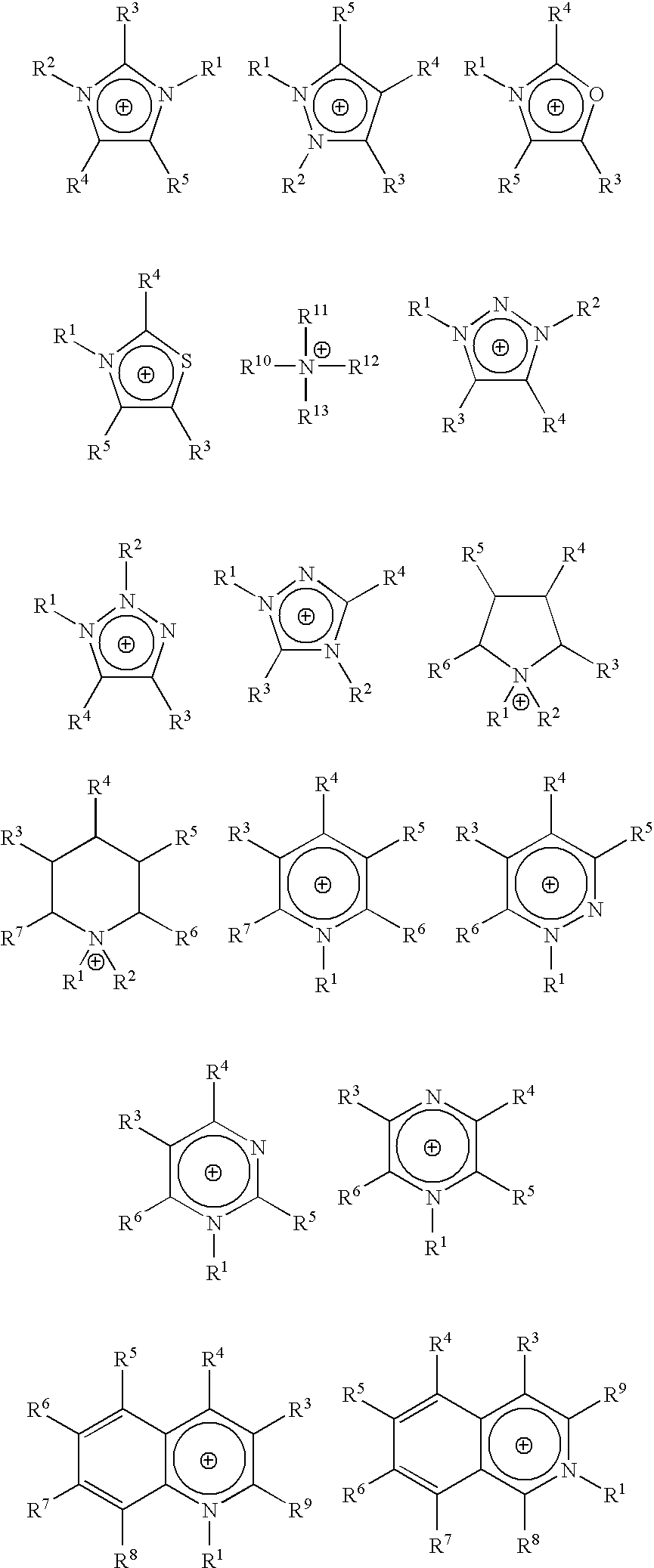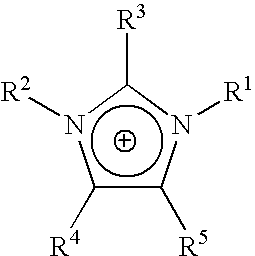Homogeneous synthesis of cellulose ethers in ionic liquids
a technology of cellulose ether and ionic liquid, which is applied in the preparation of sugar derivatives, sugar derivates, sugar derivatives, etc., can solve the problems of inability to fully dissolve cellulose ether, inability to produce cellulose ethers, and inability to meet the requirements of ionic liquid, etc., to achieve the effect of promoting the dissolution of cellulos
- Summary
- Abstract
- Description
- Claims
- Application Information
AI Technical Summary
Benefits of technology
Problems solved by technology
Method used
Image
Examples
example 1
Synthesis of 2-Hydroxypropyl Cellulose
[0090]To a solution of 28.04 g cellulose (limiting viscosity number [η]Cuen=116) in 214.4 g 1-ethyl-3-methyl-imidazolium acetate, 121 ml propylene oxide were carefully added and the reaction mixture stirred for 15.5 h at 70° C. and 8.5 h at 21° C. Afterwards, the reaction mixture was added to 1 l acetone / ethanol-mixture 25:75 and 2-hydroxypropyl cellulose (Table 1, sample A) precipitated. After the product was dissolved in water the solution is added to 4 l ethanol and the product was isolated, washed with ethanol and air-dried.
[0091]The completely DMSO- and water-soluble hydroxypropyl cellulose showed MS=0.89 determined by the method of Zeisel (yield 22.1 g).
[0092]13C NMR (135 MHz, DMSO-d6): δ=102,5 (C-1), 80,5 (C-4), 79 (C-1 in 2-hydroxy-propyl), 75 (C-5), 73,5 (C-2, C-3), 66 (C-2 in 2-hydroxy-propyl), 61 (C-6), 20,5 (C-3 in 2-hydroxy-propyl)
example 2
Synthesis of 2-Hydroxypropylcellulose
[0093]To a solution of 13 g cellulose ([η]Cuen=116) in 99.3 g 1-ethyl-3-methyl-imidazolium acetate, 118 ml propylene oxide were carefully added and the reaction mixture stirred at 70° C. After 24 h the 2-hydroxypropyl cellulose (Table 1, sample B) was isolated by adding to 1.5 l methanol, washed with methanol and air-dried.
[0094]The completely DMSO- and water-soluble hydroxypropyl cellulose showed MS=0.73 determined by the method of Zeisel (yield 13.6 g).
example 3
Synthesis of 2-Hydroxyethyl Cellulose
[0095]To a solution of 6.5 g cellulose ([η]Cuen=116) in 49.7 g 1-ethyl-3-methyl-imidazolium acetate, 5 ml ethylene oxide every 20 minutes (total amount of ethylene oxide 20 ml) were carefully added under stirring at 80° C. for a total of 19 h. The water-soluble hydroxyethyl cellulose (Table 1, sample G) was isolated by precipitation in 2.5 l isopropyl alcohol, dissolved in water and precipitated in 3 l isopropyl alcohol, washed and air-dried.
[0096]The completely DMSO- and water-soluble hydroxyethyl cellulose showed MS=1.07 determined by the method of Zeisel (yield 5.2 g).
[0097]13C NMR (135 MHz; DMSO-d6): δ=103 (C-1), 82 (C-2-s; C-3 s), 80,5 (C-4), 76,5 (C-5), 74,5 (C-2; C-3), 70,5 (C-1 in 2-hydroxy-ethyl), 61, 60,5.
PUM
| Property | Measurement | Unit |
|---|---|---|
| melting point | aaaaa | aaaaa |
| melting point | aaaaa | aaaaa |
| melting point | aaaaa | aaaaa |
Abstract
Description
Claims
Application Information
 Login to View More
Login to View More - R&D
- Intellectual Property
- Life Sciences
- Materials
- Tech Scout
- Unparalleled Data Quality
- Higher Quality Content
- 60% Fewer Hallucinations
Browse by: Latest US Patents, China's latest patents, Technical Efficacy Thesaurus, Application Domain, Technology Topic, Popular Technical Reports.
© 2025 PatSnap. All rights reserved.Legal|Privacy policy|Modern Slavery Act Transparency Statement|Sitemap|About US| Contact US: help@patsnap.com



